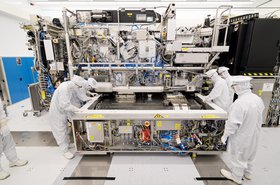Nvidia’s 1kW B200 Blackwell GPU isn’t even in the hands of customers yet, but the semiconductor behemoth has already named its successor: Rubin.
And, seemingly not content with the company’s recent $3 trillion market cap, Nvidia CEO Jensen Huang also announced that the company’s updated roadmap will see it launch a new product family every year.
Nvidia clearly has set its sights on shoring up its market domination and growing customer demand for Blackwell GPUs ahead of their release. This has left manufacturers struggling to keep pace supply-side, proving that it is still very much Nvidia’s world, and we’re all just living in it.
However, rumor has it, Nvidia is not the only company looking to 1kW and beyond. AWS recently teased that its next-generation Trainium3 chip might consume similar amounts of power, while Intel is thought to be cooking up a chip that could hit 1.5kW.
AMD’s CEO Dr. Lisa Su also used her Computex keynote speech to similarly announce that the chip company would also be bringing a new product to market each year.
But, in their attempts to support ever-growing workloads, particularly in the wake of the generative AI boom, are hardware companies about to start outpacing data center infrastructure? And what environmental impact could this continuous race to the top of the chip pile have on the planet?
When a chip goes above 1,000 watts, it requires liquid cooling. While this technique has been used to cool compute hardware in some capacity since the 1960s, we now may be nearing its technical limits.
While single-phase immersion liquid cooling can currently reach around 1kW - just about keeping up with Nvidia, two-phase immersion cooling – which could be used to handle processors with higher TDPs, is not without its challenges, as retrofitting data centers to support the technology can be complicated and costly.
It’s also worth noting that months out from its Blackwell release, Nvidia has still not confirmed the optimal temperature that its liquid-cooled GB200 DGX SuperPod should be cooled to.
However, what is perhaps even more worrying, the expensive dielectric liquids used in two-phase cooling can contain fluorocarbons or perfluoroalkyl substances (PFAS), synthetic chemicals otherwise known as ‘forever chemicals.’ These do not break down when released into the environment, and can therefore build up in people or animals over time.
At a recent event in London, an executive from HPE said that its liquid cooling technology can currently support Nvidia’s entire product portfolio but added it was right to acknowledge that chips were only going in one direction, and therefore power constraints could become a limiting factor in the future.
As a result, it’s unclear how long it can keep pace with Nvidia, and other chip makers’, high-speed product roadmap.
To complicate matters further, a recent report from the think tank Interface said that developing chemical cleaning solutions or bringing non-PFAS chemical alternatives to market could take decades. Again, Nvidia is planning to release a new family of what one can only assume will be increasingly powerful GPUs every year.
And it's not just how we keep these future chips cool that is a cause for concern.
Amid the rise in AI workloads, even though 1kW chips are yet to be a data center mainstay, it has already been estimated that 47GW of incremental grid capacity will be needed to serve data center-driven load growth in the US through 2030.
Elsewhere, that same Interface report warned that the level of semiconductor manufacturing the European Union (EU) is hoping to foster under the EU Chips Act could cause the continent’s industry to generate as much greenhouse gas as Europe’s chemical, iron, steel, and aviation sectors.
Production of Blackwell chips is already well underway in Taiwan, manufactured using a custom-built 4NP TSMC process. While TSMC has a net zero by 2050 policy in place and has taken steps to try and reduce its emissions, the company’s electricity consumption is by far its biggest greenhouse gas emitter. In 2023, it was reported that TSMC was consuming approximately six percent of Taiwan’s entire grid.
For context, that is the same percentage of electricity currently being generated by renewable energy across Taiwan.
While TSMC isn’t to blame for Taiwan relying so heavily on imported fossil fuels, regrettably, its consumption, and therefore its emissions, are expected to increase significantly as the company adopts the energy-intensive extreme ultraviolet lithography processes.
As increasingly power-hungry chips are undoubtedly on the horizon, and set to be purchased in even greater numbers, might it be time for chip companies and data center operators to come together and take stock, and consider whether the planet, let alone their data center, is really ready for hardware with energy consumption of 1kW and beyond?





